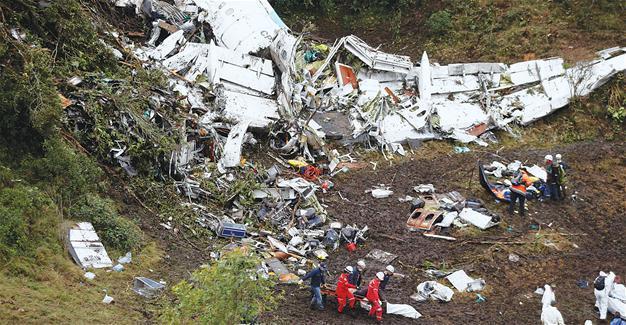Colombia confirms crashed plane was out of fuel
BOGOTA
 Preliminary investigations have confirmed that a plane that crashed in the Colombian mountains last month killing 71 people including most of a Brazilian football team was out of fuel, officials said Dec. 26.
Preliminary investigations have confirmed that a plane that crashed in the Colombian mountains last month killing 71 people including most of a Brazilian football team was out of fuel, officials said Dec. 26.The LaMia airlines charter flight crashed just outside Medellin on Nov.28, virtually wiping out the Chapecoense Real football club as they traveled to the biggest match in their history.
Freddy Bonilla, the head of Colombia’s civil aviation authority, said investigations indicated the British Aerospace 146 jet had run out of fuel.
That has been the leading theory on the crash ever since a harrowing recording emerged of the pilot radioing the control tower to report a fuel emergency.
The pilots “were aware of the fuel limitations they had at the time. It was neither adequate nor sufficient,” Bonilla told a press conference.
However, they did not sound the alarm until several minutes before the crash, he said.
The civil aviations authority said in its investigation that the plan for the flight operated by Bolivia-based charter company LaMia did not meet international standards and a series of human errors had lead to the crash. Among the errors made were the decisions to let the plane take off without enough fuel to make the flight safely and then to not stop midway to refuel.
Neither the company nor Bolivian authorities should have allowed the plane to take off with the flight plan submitted, said Bonilla. He said the agency’s preliminary conclusions were based on the plane’s black boxes and other evidence.
The plane was overweight by about 500 kilograms (1,100 pounds), but that did not appear to have played a “decisive” role, he added.
The BAE 146 Avro RJ85 has a maximum range was 2,965 kilometers (1,600 nautical miles) - just under the distance between Medellin and Santa Cruz, Bolivia, where the plane had taken off at almost full capacity.
The plane was in the air for about 4 hours and 20 minutes when air traffic controllers in Medellin put it into a holding pattern because another flight had reported a suspected fuel leak and was given priority.
According to the civil aviation authority, the pilots requested priority to land at 9:49 p.m. (2:49 a.m. GMT) because of a fuel problem. They then began their descent before receiving authorization.
At 9:53 p.m., one of their engines stopped. Three minutes later, all four were gone.
The plane declared an emergency at 9:57 p.m. because of a “total electrical failure,” then disappeared from the radar. A minute later, the pilots descended to 9,000 feet - 1,000 less than the minimum altitude for the region.
At 9:58 p.m., the plane slammed into the Cerro Gordo mountain at a speed of 115 knots (around 130 miles per hour).
Investigators found that crew members of the LaMia flight were aware of the lack of fuel but waited too long to report the emergency.
Bonilla said that during the flight the pilot and co-pilot are heard on “various occasions” talking about stopping in Leticia - a city near the borders separating Brazil, Peru and Colombia - to refuel but decided not to do so.
When the plane entered Colombian airspace it was flying into a wind, which caused more fuel to be consumed.
















